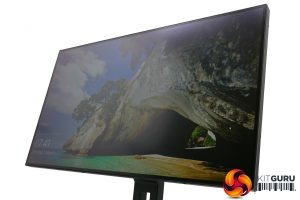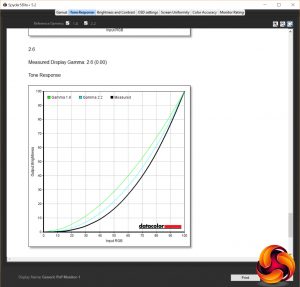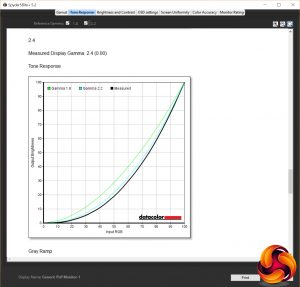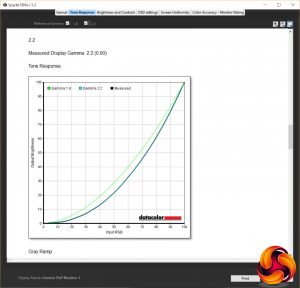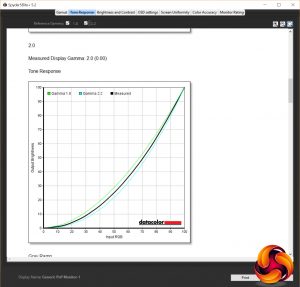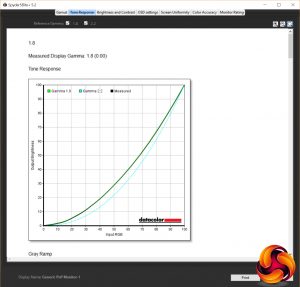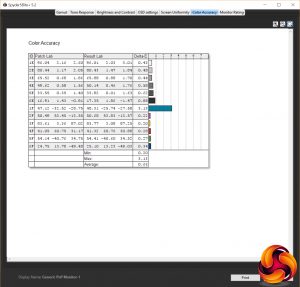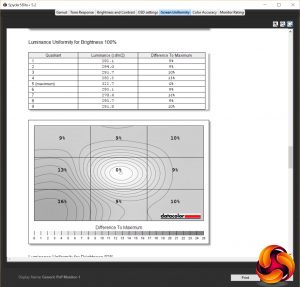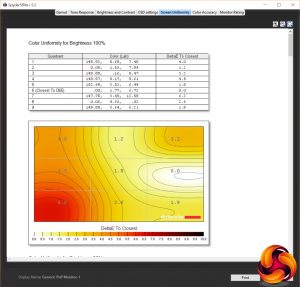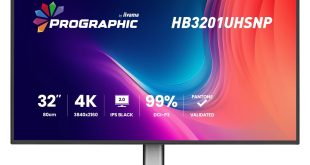The moment you fire up this screen, the quality of its image is plain to see. It looks great from every angle, colours have real zing and contrast between the brightest and darkest colours is nice and strong. Then of course there’s the resolution that means everything look pin sharp.
Using the 150% Windows scaling option works well, providing a boost in effective resolution over 1440p displays, while keeping things readable. Plus, you get the extra detail of the full resolution when apps support it – such as when using Photoshop, watching video and of course gaming.
Windows scaling can generally be relied upon to keep everything looking as it should but does slip up occasionally, with some apps appearing at native resolution, and some appearing a bit soft and blurry when enlarged. It’s seldom a major headache though.
But back to those colourful colours, and there’s something crucial to note about them, which is that they’re technically too colourful, at least if you’re not working in a high gamut colour space such as Rec.709 or DCI-P3. As per the normal sRGB colour space that Windows uses this display is over saturated, with some colours looking bolder than they should.
To get round this you’ll want to switch the display to sRGB mode for normal use, and especially for when you’re editing any images. Again, unless you’re specifically working in a high gamut colour space.
Putting that into numbers, we measured the colour space coverage of the monitor in its default Standard colour mode and sure enough this display covers 131% of the sRGB space. That corresponds to 96.1% of the DCI-P3 colour space, meaning this display passes the 90% coverage required for the Ultra HD Premium standard for HDR content.
Switching to sRGB and things are brought back into line, with our colorimeter reporting 95.9% coverage.
However, engaging the sRGB mode also affects the colour temperature. In Standard mode the display is just about perfect, hitting 6441K, where the ideal is 6500K. In sRGB mode, though, this figure drops to 6139K.
This is a bit of a stumbling block, and having the sRGB mode be so locked down is also a bit frustrating, given the wide colour gamut of this display. It means you can’t calibrate the display other than in software, which can be a bit limiting.
Meanwhile, switch to the HDR mode and the display isn’t fundamentally much different from its standard mode. The key thing this display delivers is the wider colour gamut that the HDR10 spec requires.
What this display can’t do, though, is meet the HDR10 contrast requirements. It specifies a 10,000:1 contrast ratio, which can only be achieved on LCD screens by employing local backlight dimming. That’s where the backlight is made up of hundreds of individual LEDs that turn on and off in accordance with what’s on screen. The PE320QK, however, employs a conventional uniform backlight.
That said, this monitor gets closer to true HDR than most. It uses an IPS LCD panel, and these normally can’t push much beyond a contrast of 1000:1. Here, though, this display manages 1453:1. That’s a significant increase that’s clearly noticeable, with darker colours appearing deeper and richer.
One thing this display absolutely nails is its gamma performance. It offers five different settings – 1.8, 2.0, 2.2, 2.4 and 2.6 – and every single one delivers its figure exactly.
Overall colour accuracy is also exceptional, with an average Delta E of just 0.60 and maximum of 3.13. Anything below 3.0 is considered imperceptible to the human eye while below 1.0 is something only the best panels achieve.
The uniformity of this display is little less impressive. With it being so large, it’s no surprise it struggles a little, but for a professional display we’d hope for a little better. With a peak brightness variance of 16% and average of 9.4%, it’s no better than some far cheaper displays.
Colour uniformity is better, with a peak of 6.2% and average of 2.8%, though again it’s not significantly better than cheaper displays.
With our use mainly being in the sRGB colour space, we selected this mode then did a software calibration using the Datacolor Sypder5 Elite colorimeter and really it made very little difference. Largely this is because the display is so good already, though notably it didn’t affect the colour balance.
Gaming
This isn’t the sort of display that you’d necessarily prioritise for gaming. However, Acer has done what it can to make this display as good as it can for those who like to play as well as work.
The two most crucial things are that input lag is minimal and response time is 4ms, so although you’re not getting the lightning fast feel of 144Hz+ displays, it doesn’t feel unplayably sluggish.
Then there’s Freesync that ensures you get a smooth, tear-free experience.
The upshot is that for any games that aren’t reliant on super-speedy refresh rates, this display is fantastic. Its responsive enough and the combination of Freesync, 4K and the stunning image quality makes for a sometimes jaw-dropping spectacle.
 KitGuru KitGuru.net – Tech News | Hardware News | Hardware Reviews | IOS | Mobile | Gaming | Graphics Cards
KitGuru KitGuru.net – Tech News | Hardware News | Hardware Reviews | IOS | Mobile | Gaming | Graphics Cards


